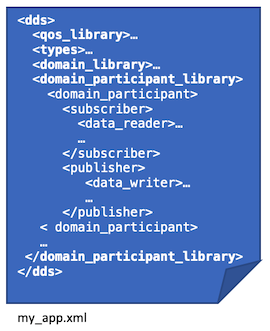3. Defining a DDS system in XML¶
Connector loads the definition of a DDS system from an XML configuration file that includes the definition of domains, DomainParticipants, Topics, DataReaders and DataWriters, data types and quality of service.

Connector uses the XML schema defined by RTI’s XML-Based Application Creation feature.
Hint
The Connext DDS C, C++, Java and .NET APIs can also load the same XML files you write for Connector.
The following table summarizes the XML tags, the DDS concepts they define, and how they are exposed in the Connector API:
| XML Tag | DDS Concept | Connector API |
|---|---|---|
<types> |
DDS data types (the types associated with Topics) | Types used by inputs and outputs (Input and Output). |
<domain_library>, <domain>, <register_type> and <topic> |
DDS Domain, Topic | Defines the domain joined by a Connector and the Topics used by
its inputs and outputs (Input and Output). |
<domain_participant_library> and <domain_participant> |
DomainParticipant | Each Connector instance loads a <domain_participant>. See Loading a Connector. |
<publisher> and <data_writer> |
Publisher and DataWriter | Each <data_writer> defines an Output. See Writing data (Output). |
<subscriber> and <data_reader> |
Subscriber and DataReader | Each <data_reader> defines an Input. See Reading data (Input). |
<qos_library> and <qos_profile> |
Quality of service (QoS) | Quality of service used to configure Connector, Input
and Output. |
Hint
For an example configuration file, see ShapeExample.xml.
3.1. Data types¶
The <types> tags define the data types associated with the Topics to be published
or subscribed to.
The following example defines a ShapeType with four members: color, x, y
and shapesize:
<types>
<struct name="ShapeType">
<member name="color" type="string" stringMaxLength="128" key="true"/>
<member name="x" type="int32"/>
<member name="y" type="int32"/>
<member name="shapesize" type="int32"/>
</struct>
</types>
Types are associated with Topics, as explained in the next section, Domain library.
Hint
You can define your types in IDL and convert them to XML with rtiddsgen.
For example: rtiddsgen -convertToXml MyTypes.idl
For more information about defining types, see Creating User Data Types with XML in the RTI Connext DDS Core Libraries User’s Manual.
For more information about accessing data samples, see Accessing the data.
3.2. Domain library¶
A domain library is a collection of domains. A domain specifies:
<domain_library name="MyDomainLibrary">
<domain name="MyDomain" domain_id="0">
<register_type name="ShapeType" type_ref="ShapeType"/>
<topic name="Square" register_type_ref="ShapeType"/>
<topic name="Circle" register_type_ref="ShapeType"/>
</domain>
</domain_library>
For more information about the format of a domain library, see XML-Based Application Creation: Domain Library.
3.3. Participant library¶
A DomainParticipant joins a domain and contains Publishers and Subscribers, which contain DataWriters and DataReaders, respectively.
Each Connector instance created by your application is associated with a
<domain_participant>, as explained in Loading a Connector.
DataReaders and DataWriters are associated with a DomainParticipant and a
Topic. In Connector, each <data_writer> tag defines an Output,
as described in Writing data (Output); and each <data_reader> tag defines
an Input, as described in Reading data (Input).
<domain_participant_library name="MyParticipantLibrary">
<domain_participant name="MyPubParticipant" domain_ref="MyDomainLibrary::MyDomain">
<publisher name="MyPublisher">
<data_writer name="MySquareWriter" topic_ref="Square" />
</publisher>
</domain_participant>
<domain_participant name="MySubParticipant" domain_ref="MyDomainLibrary::MyDomain">
<subscriber name="MySubscriber">
<data_reader name="MySquareReader" topic_ref="Square" />
</subscriber>
</domain_participant>
</domain_participant_library>
For more information about the format of a participant library, see the XML-Based Application Creation Getting Started Guide.
3.4. Quality of service¶
All DDS entities have an associated quality of service (QoS). There are several ways to configure it.
You can define a QoS profile and make it the default. The following example configures all DataReaders and DataWriters with reliable and transient-local QoS:
<qos_library name="MyQosLibrary">
<qos_profile name="MyQosProfile" is_default_qos="true">
<datareader_qos>
<reliability>
<kind>RELIABLE_RELIABILITY_QOS</kind>
</reliability>
<durability>
<kind>TRANSIENT_LOCAL_DURABILITY_QOS</kind>
</durability>
</datareader_qos>
<datawriter_qos>
<reliability>
<kind>RELIABLE_RELIABILITY_QOS</kind>
</reliability>
<durability>
<kind>TRANSIENT_LOCAL_DURABILITY_QOS</kind>
</durability>
</datawriter_qos>
</qos_profile>
</qos_library>
You can define the QoS for each individual entity:
<domain_participant name="MyPubParticipant" domain_ref="MyDomainLibrary::MyDomain">
<participant_qos> <!-- ... --> </participant_qos>
<publisher name="MyPublisher">
<publisher_qos> <!-- ... --> </publisher_qos>
<data_writer name="MySquareWriter" topic_ref="Square">
<datawriter_qos>
<reliability>
<kind>RELIABLE_RELIABILITY_QOS</kind>
</reliability>
<durability>
<kind>TRANSIENT_LOCAL_DURABILITY_QOS</kind>
</durability>
</datawriter_qos>
</data_writer>
</publisher>
</domain_participant>
Or you can use profiles and override or define additional QoS policies for each entity:
<domain_participant name="MyPubParticipant" domain_ref="MyDomainLibrary::MyDomain">
<participant_qos base_name="MyQosLibrary::MyQosProfile">
<!-- override or configure additional QoS policies -->
</participant_qos>
<publisher name="MyPublisher">
<publisher_qos base_name="MyQosLibrary::MyQosProfile">
<!-- override or configure additional QoS policies -->
</publisher_qos>
<data_writer name="MySquareWriter" topic_ref="Square">
<datawriter_qos base_name="MyQosLibrary::MyQosProfile">
<!-- override or configure additional QoS policies -->
</datawriter_qos>
</data_writer>
</publisher>
</domain_participant>
You can also use builtin profiles and QoS snippets. For example, the following profile is equivalent to MyQosProfile above:
<qos_library name="MyQosLibrary">
<qos_profile name="MyQosProfile" is_default_qos="true">
<base_name>
<element>BuiltinQosSnippetLib::QosPolicy.Durability.TransientLocal</element>
<element>BuiltinQosSnippetLib::QosPolicy.Reliability.Reliable</element>
</base_name>
</qos_profile>
</qos_library>
You can read more in the RTI Connext DDS Core Libraries User’s Manual, Configuring QoS with XML.
3.4.1. Logging¶
Logging can be configured as explained in Configuring Logging via XML.
For example, to increase the logging verbosity from the default (ERROR) to
WARNING, define a qos_profile with the attribute
is_default_participant_factory_profile="true":
<qos_profile name="Logging" is_default_participant_factory_profile="true">
<participant_factory_qos>
<logging>
<verbosity>WARNING</verbosity>
</logging>
</participant_factory_qos>
</qos_profile>